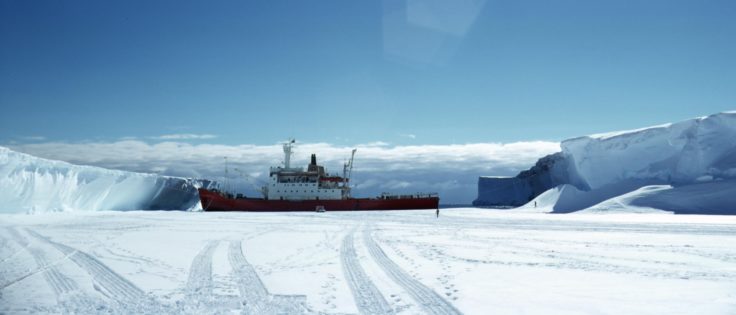The RRS Bransfield was an ice-strengthened cargo vessel, purpose-built for operation by the British Antarctic Survey (BAS). She was launched at Leith on 4 September 1970, by Lady Joyce Fuchs, wife of the Survey’s then director, Sir Vivian Fuchs.
She was designed by consultants Graham & Woolnaugh of Liverpool for NERC, and built by Robb Caledon Shipbuilders Ltd, Leith.
The Bransfield was BAS’s main supply vessel from 1970/71-1998/99, and also had limited facilities for on-board research. She represented NERC in the Review of the Fleet at Spithead in 1977, held to celebrate Queen Elizabeth II’s Silver Jubilee.
Naming
The choice of the name honoured a British explorer who had made a significant contribution to the discovery of that part of Antarctica in which British research activities were centered at the time, namely the Antarctic Peninsula.
Edward Bransfield, Royal Navy (1785-1852) was either the master or navigator of HMS Andromache, based at Valparaiso, Chile, when news was received of a sighting of land further south than hitherto known. Bransfield commandeered a whaling brig, the Williams, and during 1819-20 discovered the north west coast of the Antarctic Peninsula, roughly surveyed the South Shetland Islands and claimed King George Island and Clarence Island for Great Britain. Bransfield was the first man to chart part of the Antarctic mainland.
This was in fact the second vessel to be named after Bransfield by BAS or its predecessors. The first HMS Bransfield was the original expedition ship for Operation Tabarin. This vessel was a wooden Norwegian sealer built in 1918 as the Veslekari, and renamed for the expedition. Her service with Tabarin was inglorious – she proved to be unseaworthy, and had to be replaced before the expedition left English waters in November 1943.
Technical specification
- Ice classification: Lloyds 100 A1 ice class A*
- Dimensions: length 325 ft (99.2m); breadth 60 ft (18.4m); draught 22 ft (6.7m)
- Tonnage 4816 gross, 1577 net
- Propulsion: Diesel-electric 5000 SHP (single variable pitch propeller)
- Passage speed: 13.25 knots (2 engines); 10.75 knots (1 engine)
- Endurance: 55 days (2 engines); 90 days (1 engine)
- Cargo capacity: 3450 cu m (max. theoretical capacity)
- Laboratory area: 550 sq ft
- Accommodation: 13 officers; 24 crew; 58 passengers
Port of registry
Stanley, Falkland Islands.
Post-BAS service/end-of-life
Following the ship’s return to the UK in May 1999, she was sold to Rieber Shipping A/S as part of the contract for the long-term charter of her replacement, RRS Ernest Shackleton and subsequently broken-up after passage to India.
